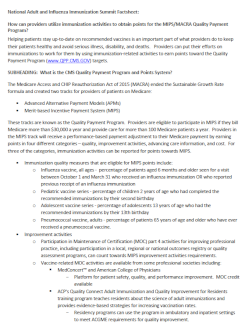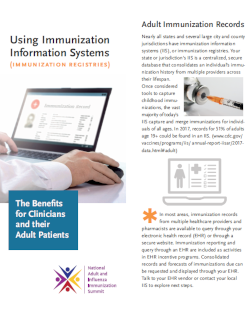IT / Documentation: Level 3
Utilize immunization registry and data-sharing options
After assessing needs, requirements, and capabilities, set up an interface between your electronic health record (EHR) and relevant registries to provide more complete, timely, and accurate patient immunization records.
While data sharing for children’s immunizations has long been required for school attendance, such consolidation of records is not yet commonplace for adult immunizations. Organizations can create more complete, accurate patient records and reduce time-consuming data entry by participating in data-sharing options such as Immunization Information Systems (IIS).
Every state has data-sharing options through IIS. IIS are secure, population-based, computerized databases that record all vaccine doses administered by participating providers to persons residing within a given geopolitical area. There are many other types of data-sharing options, such as citywide registries, health information exchanges, and data sharing via a third-party vendor (e.g., Care Everywhere).
When putting a data-sharing program into practice, consider the following:
- Current needs and resources: Which population groups and vaccines are a top priority for your organization? Which IIS or other data-sharing options are available in your region for these groups? What are their requirements?
- Your technical capabilities: Your EHR interface will determine whether you can share data one-way (e.g., from your EHR to an IIS) or two-way (e.g., also pulling data into your EHR from the IIS). While bi-directional data sharing is often more complex to set up, it enables your organization to maintain the most accurate, comprehensive dataset for your patient population.
- Steps for getting connected: Interfaces and processes differ for varying data sharing options. IIS have systems for getting connected; you will need to engage your state’s IIS as well as your IT department for this process.
- Workflow integration and training: Your organization will need to determine how to integrate data-sharing processes into your existing workflow and train staff accordingly. When using a bi-directional registry, determine when and how you intend to match a patient with options in the registries. For example, matching during chart prep may fit well into your workflow, and variables such as address, age, and gender are often used to match patient identities. Consult with your IT department on these details.
- Patient consent: Learn about patient consent requirements, which can vary by state, for your IIS. Based on that information, consider developing a process for securing patient consent for sharing their data or allowing patients to opt out.
- Coding: There are coding conventions for entering individual vaccine types. The Centers for Disease Control and Prevention (CDC) has a list of CVX (vaccine administered) codes.
- Compliance and the bottom line: While setting up a data-sharing interface requires significant investment, the benefits are also substantial. Leveraging data-sharing options improves interoperability and enables your organization to improve patient care, satisfy quality metrics, and achieve Merit-Based Incentive Payment System (MIPS) requirements, ultimately yielding a return on the investment.

State Immunization Websites
Immunize.org
Provides direct links to individual state immunization websites.
View Tool
MIPS and Immunization Information Systems (IIS)
National Adult and Influenza Immunization Summit (NAIIS)
Describes how clinicians leveraging immunization information systems (IIS) can earn up to 10% of their advancing care information bonus score in the Merit-Based Incentive Payment System (MIPS).
View Tool
"Using Immunization Information Systems" Factsheet
National Adult and Influenza Immunization Summit (NAIIS)
Informs providers and staff about the different benefits of using immunization information systems (IIS) for data sharing between their organization and jurisdictions to track a patient’s immunization records.
View ToolCampaign Planks
Provider & Staff Education
Clinical Support
IT / Documentation
Patient Education
